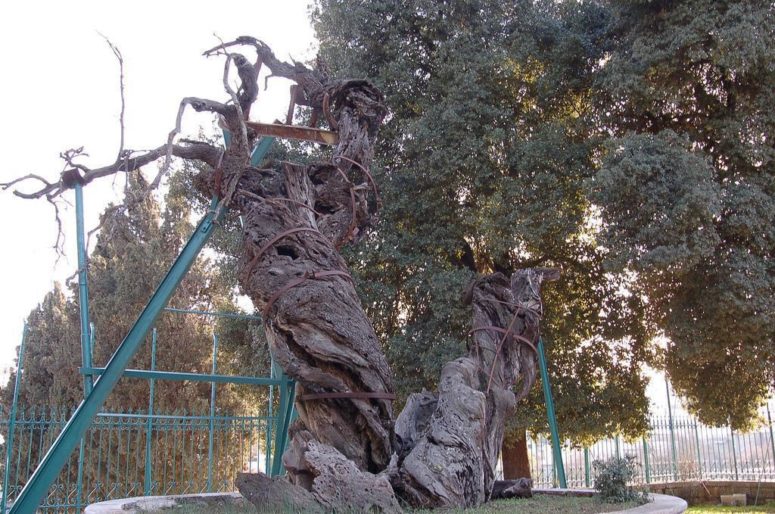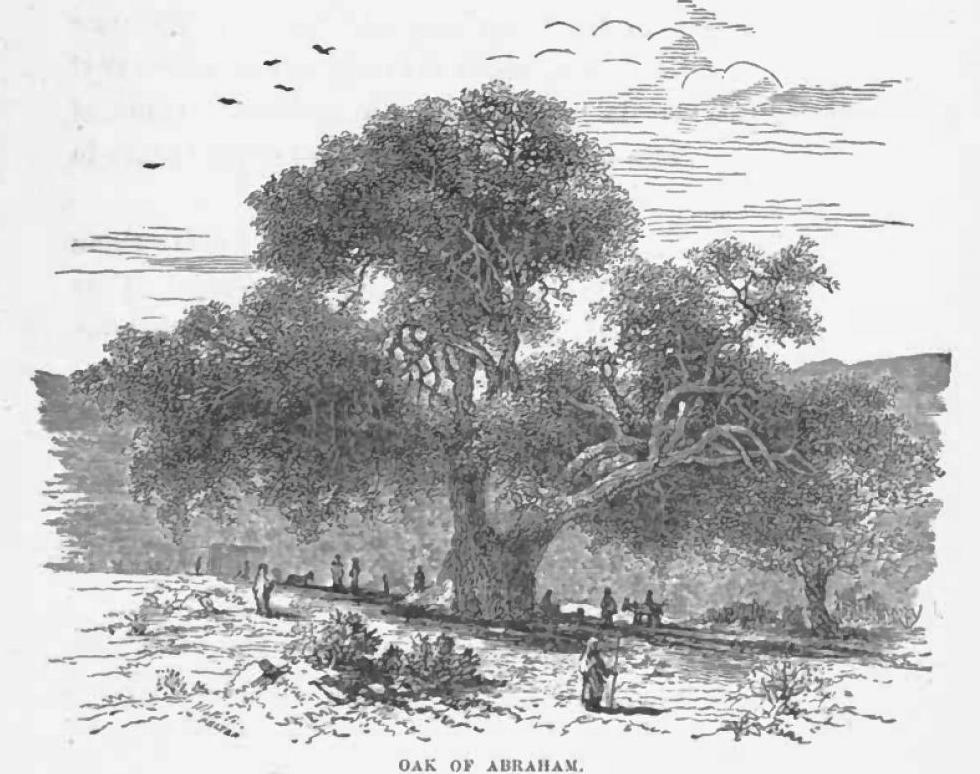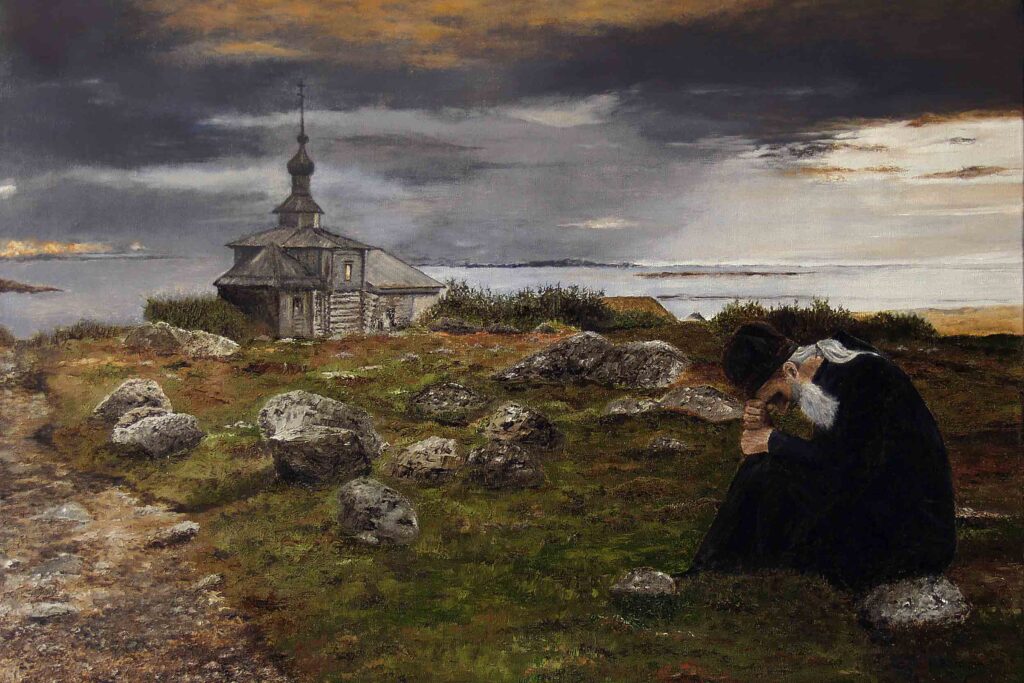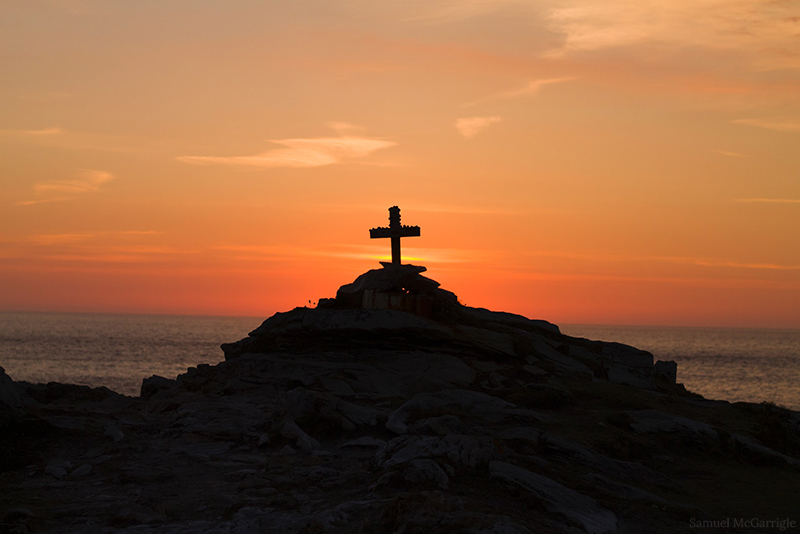
The episode at the oak of Mamre, recorded in Genesis 18, is one of the strangest and most mysterious in the scriptures. It has long been depicted in Orthodox iconography as the Hospitality of Abraham. Beginning with Andrei Rublev, a detail of this scene has been the only approved Orthodox iconographic depiction of the Holy Trinity. This Trinity icon is used by some local Orthodox churches as the icon for the feast of Pentecost. The coming of the Holy Spirit at Pentecost marked the conclusion of the revelation of the Holy Trinity to humanity. The episode of the oak of Mamre, in many ways, represents the beginning of that revelation.
Genesis 18 begins by stating that Yahweh appeared to Abraham while he was camped at the oaks of Mamre. This is not the first time in the book of Genesis that Yahweh has appeared in bodily form. He walks in the garden, for example, in Genesis 3:8. It is, however, the first time that he appears as a man. It will also not be the last. This is despite clear teaching in the scriptures that no one can see God and live (eg. Ex 33:20; 1 Tim 6:16). The former text occurs in the same chapter in which Moses is said to have spoken with Yahweh face to face (Ex 33:11).
These early encounters with Yahweh the God of Israel later came to be understood, alongside other similar encounters, as multiple hypostases of Yahweh. In this context, an unseeable Father and a Son who appears to human persons in bodily form. Within the Hebrew Scriptures, this conception is most fully and completely elaborated in the vision of Daniel 7. St. John refers to this knowledge of God in the poetic prologue to his Gospel which lays out the eternal existence of the Logos and his incarnation. “No one has seen God at any time. The unique God who is in the bosom of the Father has declared him” (1:18). St. John is not here retconning large portions of the Old Testament, including Genesis 18 in which human persons are clearly described as seeing God. Rather, he is clearly identifying the Yahweh who appeared in former times to humans in bodily form as the Logos who became incarnate, Jesus Christ.
The revelation of the Holy Trinity does not only emerge when Yahweh’s appearance at the oaks of Mamre is compared to other passages, however. It emerges from the text itself. It is important to specify against a common misinterpretation that the three men whom Abraham encounters (Gen 18:2) are not the three persons of the Holy Trinity in visible form. In addition to plainly contradicting the other passages already named, when the figures split up, only one of them is identified as Yahweh (18:22). The other two are identified as being angels when they arrive at Sodom (19:1). This is one of several places in which angelic beings are described as having bodies. Indeed, Yahweh and the two angels share a meal with Abraham (18:8). St. Jude (7-8) compares the attempted crimes of the men of Sodom to the sin of the rebellious angels before the Flood in Genesis 6:1-2.
Yahweh and the two angels do, however, speak with one voice. ‘Elohim,’ generally translated as God, when used to indicate Yahweh, often takes plural verbs because it is grammatically plural. The name Yahweh, however, is grammatically singular. Nevertheless, throughout the discussion with Abraham, the pronoun ‘they’ is used to introduce Yahweh’s speech. The three can therefore be seen to be a visible representation, an icon, of the Holy Trinity. Further, within this text, Yahweh speaks to himself, taking his own counsel (Gen 18:17-19). We see this dynamic more fully developed in the prayers of Christ to his Father in the Gospels.
Perhaps the greatest significance of this passage, however, is what it reveals to us about the person of Jesus Christ. It is Christ with whom Abraham negotiates to seek mercy even for Sodom and Gomorrah. It is Christ who sends the two angels to rescue Lot and his family before the destruction. It is also, however, Christ who brings the fire from heaven to blot out those cities in their wickedness. He can speak of being even before Abraham (John 8:58). He can speak of the sins of Sodom from direct knowledge (Matt 10:15; 11:23-24; Luke 10:12). Christ is clear that the responsibility for judgment, for restoring justice to the created order, has been given to him (John 5:22). The destruction unleashed on Sodom and Gomorrah was a foretaste, an eschatological intrusion, of the final judgment at Christ’s return (Luke 17:28-30).
Throughout the history of the church, there have been attempts to disfigure the identity of Christ by detaching the Christ whom we encounter in the Gospels from the God of the Old Testament. The first known and perhaps most infamous attempt was made by Marcion, who argued at the beginning of the second century that Yahweh was a different God than the Father of our Lord Jesus Christ, describing the former as violent and wrathful while the latter is loving and compassionate. Views of this sort are most often debunked by demonstrating the love and compassion of Yahweh in the Old Testament. The commands to love God and neighbor are drawn from the Torah, Leviticus and Deuteronomy. His mercy and compassions are continual themes in the Psalms. It can, however, be equally refuted in the opposite direction. The Christ who walked in the garden and cursed the serpent, who destroyed Sodom and Gomorrah, who led the people out of Egypt and commanded Joshua’s armies is the same Christ whom we encounter in the Gospel. The Christ of love and compassion and mercy whom we encounter in the Gospels and the teaching of the apostles which make up the rest of the New Testament is the same Christ whom we encounter in the judgment of Revelation as the avenger of innocent blood.

While true Marcionites are few and far between in our present world, a softer form of Marcionism is a constant and persistent threat. It takes the form of ignoring and allegorizing away the Old Testament presentation of God the Holy Trinity and the person of Jesus Christ. This is coupled with a one dimensional caricature of the person of Christ in the New Testament. It takes the form in some cases of denying, against the consistent testimony of scripture, the Fathers, and the liturgical tradition of the church that God has any wrath at all. It sometimes even goes so far as the heresy of universalism.
Against any such view, Hebrews tells us that Christ is the same yesterday, today, and forever (13:8). His character has never changed and will never. He is the God who calls us to repentance through the certain knowledge of coming judgment and the God who pours forth his mercy and forgiveness when we turn from our sin to follow him. He is coming soon and his reward, for both righteousness and wickedness, is with him. Over the next four weeks, posts will discuss the nature of atonement in the scriptures, beginning with the nature of the wrath of God.
Source: https://blogs.ancientfaith.com/wholecounsel/2019/06/14/the-oak-of-mamre/




